The billion-dollar voice-over industry in gaming has grown rapidly due to technological advances and increased demand for immersive storytelling. You’ll see big developers invest heavily in capturing realistic, emotional performances that enhance gameplay. From main characters to background sounds, voice actors and innovative tech shape every aspect. If you’re curious about how this industry keeps evolving with AI, AR, and new talents, there’s more to discover behind the scenes.
Key Takeaways
- The industry has evolved from basic recordings to sophisticated performances, driven by technological advances and industry training.
- Major game developers and publishers set standards, manage talent, and influence localization to appeal globally.
- Voice actors contribute versatile roles, with environmental sounds enhancing immersion and storytelling.
- Technological innovations like AI, voice modulation, and remote recording expand opportunities and reduce costs.
- Growing demand for high-quality voice-over work in gaming fuels industry expansion, with future trends including AR and real-time voice adaptation.
The Evolution of Voice Acting in Video Games
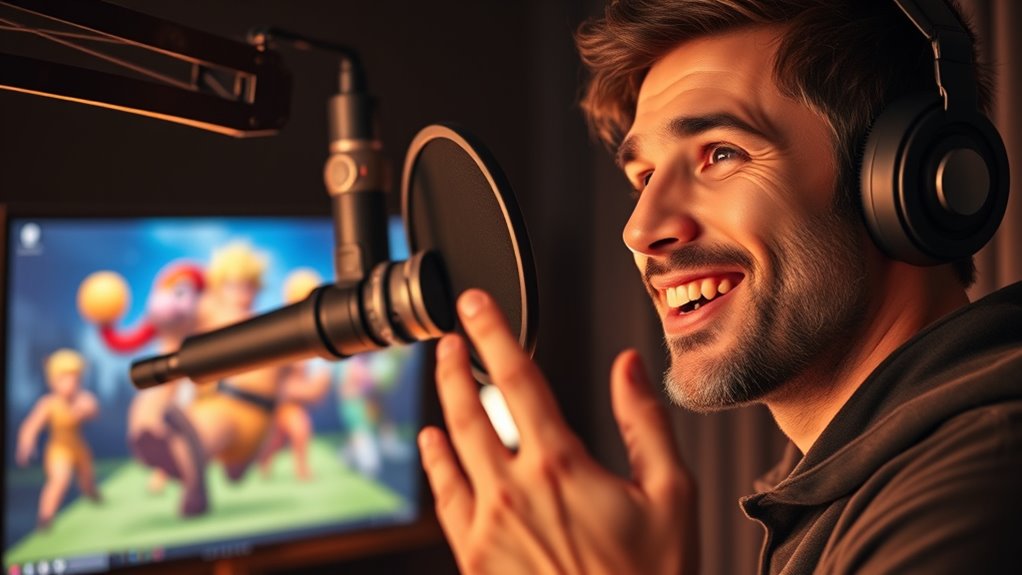
The evolution of voice acting in video games has transformed how players experience storytelling and character development. Early games used basic voice recordings, often with limited emotion and simple voice acting techniques. Over time, industry training and advances in technology allowed voice actors to deliver more natural, nuanced performances. Modern voice acting employs sophisticated techniques, capturing subtle emotions and creating more immersive experiences. As the industry grew, so did the demand for talented voice actors, leading to professional training programs that sharpen skills and improve quality. Today, voice acting is a crucial part of game design, elevating narratives and engaging players deeply. Additionally, the trustworthiness of voice acting brands has become an important factor in ensuring high-quality performances. This progression reflects how the industry continuously pushes boundaries to make game characters feel more authentic and relatable.
Key Players in the Voice-Over Industry

As voice acting becomes more integral to immersive gaming experiences, several key players shape the industry’s landscape. Indie projects often rely on passionate voice actors to bring unique stories to life, sometimes collaborating with fans or volunteers. Fan translations also influence the industry, as dedicated communities add voice-overs to localized games, expanding reach. These efforts highlight the importance of versatile talent and innovative approaches outside major studios. Consider the following:
| Contributor Type | Focus Area | Impact |
|---|---|---|
| Indie Developers | Creative storytelling | Niche, authentic voices |
| Fan Translators | Localization & fan projects | Increased accessibility |
| Voice Actors | Versatile performances | Broadened industry scope |
This landscape continues to evolve, driven by passion and community involvement. Additionally, special occasions within the industry, such as anniversary celebrations for iconic games or milestones for voice actors, often garner community support and recognition.
The Role of Major Game Developers and Publishers
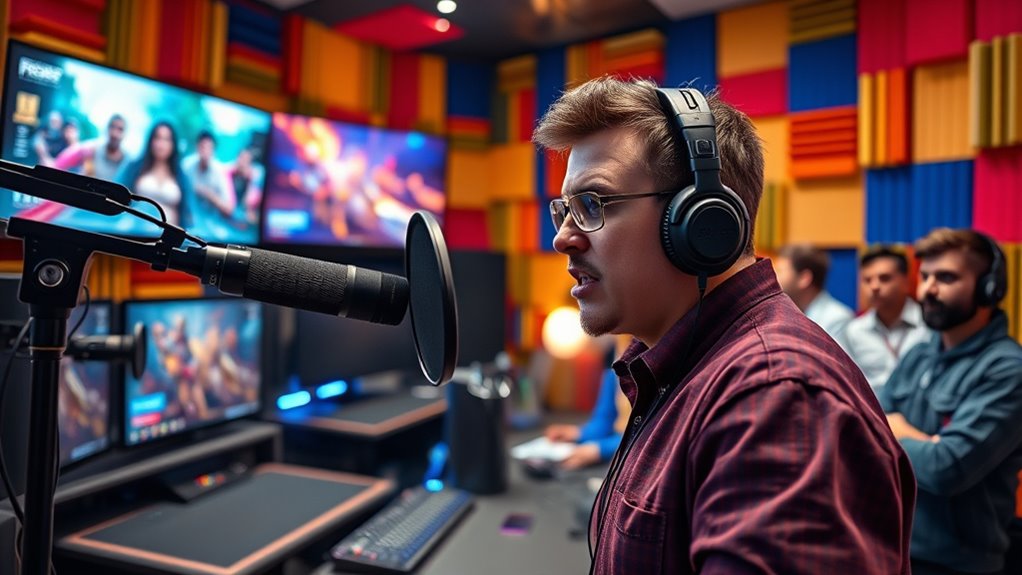
Major game developers and publishers play a pivotal role in shaping the voice-over industry by setting standards, allocating budgets, and coordinating talent. They determine how much is invested in voice-over work, influencing the quality and variety of performances. Their decisions also impact game localization efforts, ensuring that voice content resonates across different markets. Additionally, they handle voice-over licensing, securing rights for voice actors and managing legal aspects essential for global releases. By orchestrating these elements, developers and publishers control the scope and consistency of voice work, which directly affects player immersion and game success. Their strategic choices drive industry trends, from hiring practices to the integration of voice technology, making them key drivers of innovation and quality in gaming’s billion-dollar voice-over landscape. Incorporating Cultural Intelligence into their processes enables these companies to better understand diverse player preferences and cultural nuances, further enhancing the global appeal of their games.
Types of Voice Work in Gaming: From Main Characters to Backgrounds
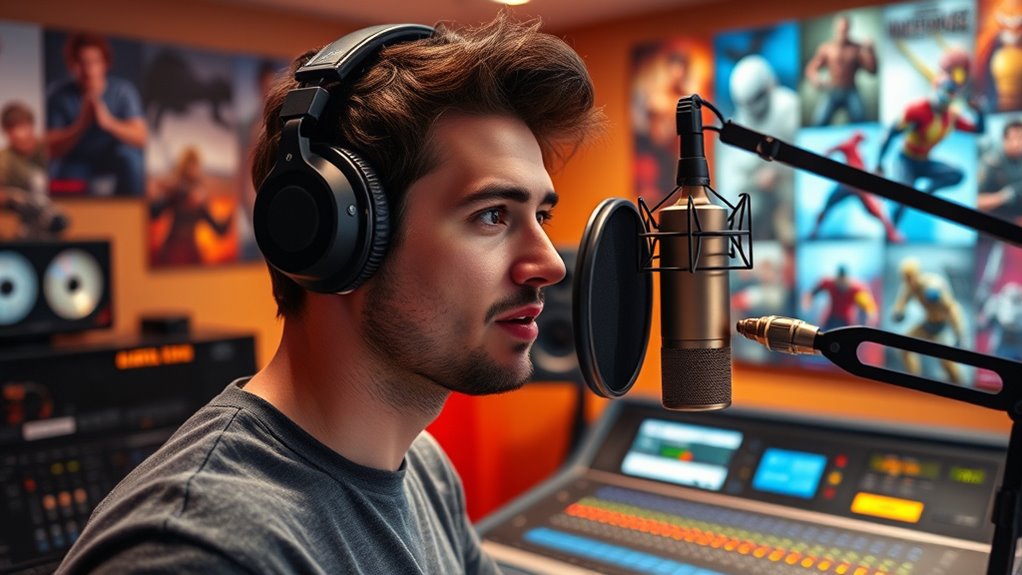
In gaming, your voice work can range from bringing main characters to life to creating immersive background sounds. You’ll find yourself voicing iconic heroes or adding subtle environmental noises that enhance the experience. Understanding these different roles helps you see how diverse and essential voice-over work is in gaming. Additionally, utilizing professional equipment ensures high-quality recordings that meet industry standards.
Main Character Voices
Main character voices are among the most recognizable and demanding roles in the gaming industry. They require mastery of voice acting techniques to bring characters to life and support character development. As the player’s primary connection, your voice must convey emotion, personality, and motivation convincingly. Whether voicing a hero, villain, or complex anti-hero, you adapt your tone and style to match the character’s arc. Here’s a quick look at some common main character voice types:
| Voice Type | Description |
|---|---|
| Heroic | Confident, inspiring, brave |
| Villain | Menacing, cunning, sinister |
| Anti-Hero | Flawed, conflicted, relatable |
| Supporting Lead | Charismatic, nuanced, versatile |
Environmental and Background Sounds
While voiced characters bring personalities to life, the soundscape of a game extends beyond dialogue to include environmental and background sounds that enrich the player’s experience. These ambient layers create immersive soundscapes, transporting you to different worlds and settings. As a voice-over artist, your work might involve capturing sounds of bustling cities, eerie forests, or bustling marketplaces, adding depth and realism. Carefully crafted ambient sounds set the mood, influence pacing, and enhance storytelling without overpowering main dialogue. Your voice work might include subtle background voices, distant echoes, or atmospheric noises that make the environment feel alive. By blending these elements seamlessly, you help players feel truly immersed, making every moment more authentic and engaging.
The Process of Recording and Producing Game Voices
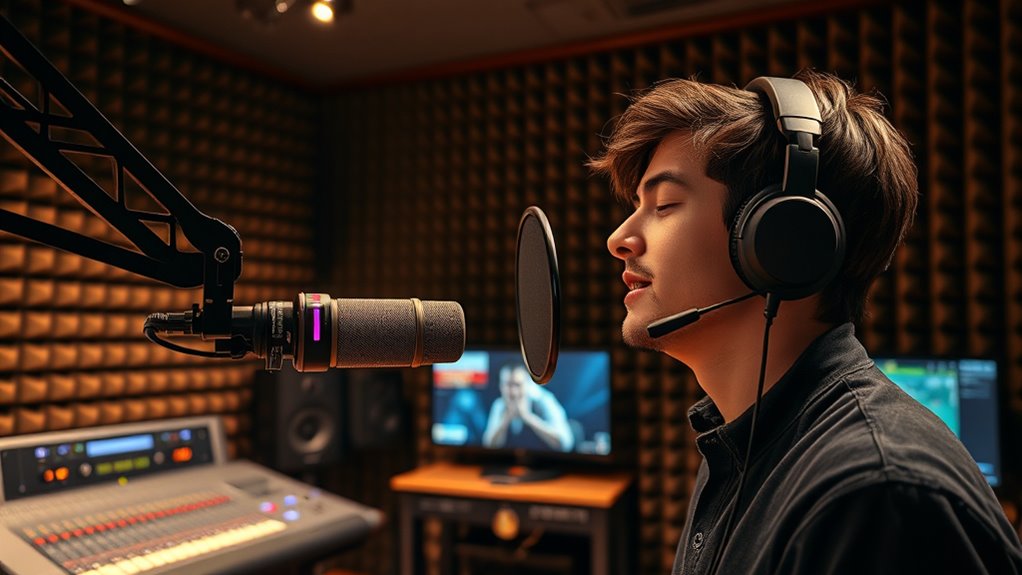
You’ll start with voice casting and selection, choosing the right actors to bring characters to life. Next, recording sessions capture the performances, and then the audio moves into post-production for editing and final touches. This process guarantees that every voice fits seamlessly into the game’s world and story. Incorporating ethical hacking techniques can also help ensure the security and integrity of the recording and distribution systems involved in game voice production.
Voice Casting and Selection
Selecting the right voices for a game involves a detailed casting process that guarantees each character’s personality and tone are accurately conveyed. You’ll work closely with casting agency dynamics to find voices that match the character’s traits and story. It’s important to prioritize voice actor diversity, ensuring a range of backgrounds, accents, and perspectives are represented. This diversity enriches the game’s authenticity and broadens its appeal. During casting, you evaluate auditions, looking for performances that capture emotion and authenticity. The process often involves multiple rounds of callbacks and feedback to refine choices. By carefully selecting voices through these steps, you ensure that each character feels genuine, immersive, and memorable, ultimately elevating the gaming experience for players worldwide.
Recording and Post-production
Once the perfect voices are cast, the recording process begins, transforming auditions into authentic character performances. You’ll work in a soundproof studio, guiding actors to deliver nuanced emotions through voice modulation that matches the character’s personality. During recording, you may capture multiple takes to guarantee the right tone and timing. Afterward, the recordings move into post-production, where sound design plays a vital role. You’ll edit out errors, enhance clarity, and add effects to create immersive audio. Sometimes, you’ll layer different voice tracks or adjust pitch and intensity to achieve the desired impact. This process ensures that every line resonates with players, bringing characters to life through meticulously crafted sound that complements the game’s visual and narrative elements.
Challenges and Opportunities for Voice Actors
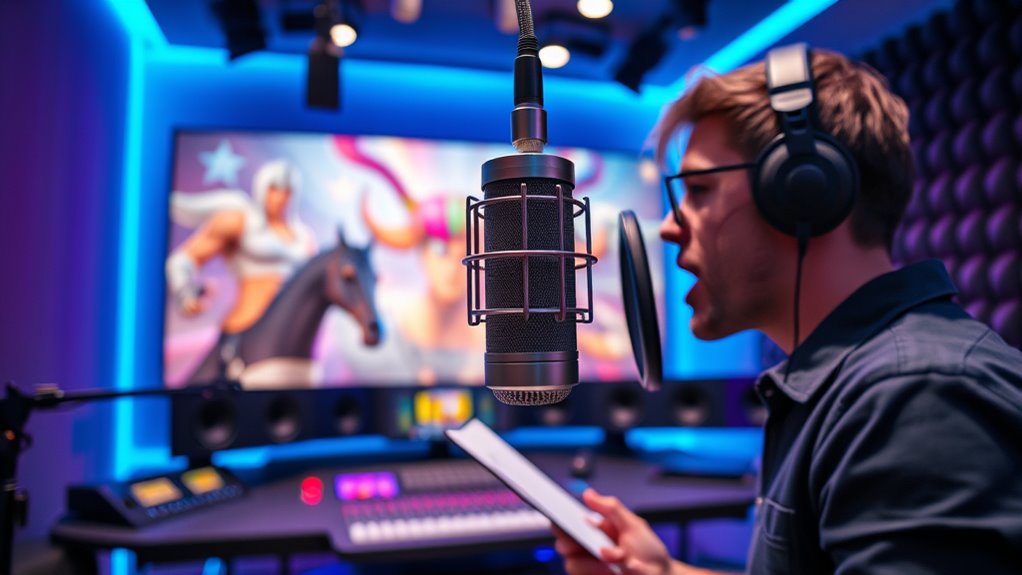
The voice-over industry in gaming presents both significant challenges and promising opportunities for actors willing to adapt. You may face issues like voice actor burnout from intense schedules and repetitive recordings, which can affect performance. Contractual disputes can also arise, limiting your control and earning potential. However, new opportunities include expanding into diverse roles, building a personal brand, and working remotely. By staying flexible and honing your skills, you can stand out in a competitive market. Additionally, forming strong relationships with developers and agents can open doors to steady work. Embracing ongoing learning helps you keep pace with industry changes. Overall, while hurdles exist, proactive adaptation can lead to a sustainable, lucrative career in gaming’s voice-over industry.
- Steering through burnout and maintaining motivation
- Managing contractual negotiations effectively
- Diversifying voice roles and genres
- Building a strong personal brand
- Leveraging remote recording opportunities
The Impact of Technology on Voice-Over Production
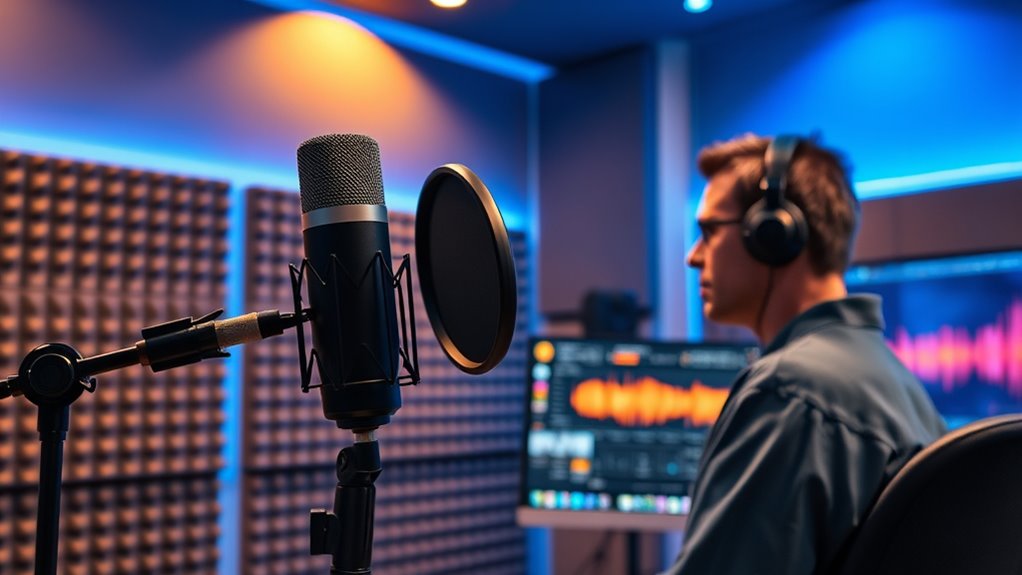
Advancements in technology have revolutionized the voice-over industry in gaming, making production more efficient and accessible. You now have tools like voice modulation software that allow you to alter tone, pitch, and emotion instantly, reducing the need for multiple takes. Script adaptation has also become easier, with digital editing enabling quick revisions and localization, ensuring your voice fits different game scenarios and languages seamlessly. These innovations save time and costs while enhancing the quality of performance. You can experiment with different vocal styles and tweak recordings on the fly, giving you greater creative control. Additionally, the integration of high-quality audio equipment and home cinema setups allows for better monitoring and editing of voice recordings, further improving the final output. Overall, technology empowers you to deliver dynamic, polished voice-overs more efficiently than ever before, transforming how games are voiced and experienced.
Economic Factors Driving Growth in the Industry
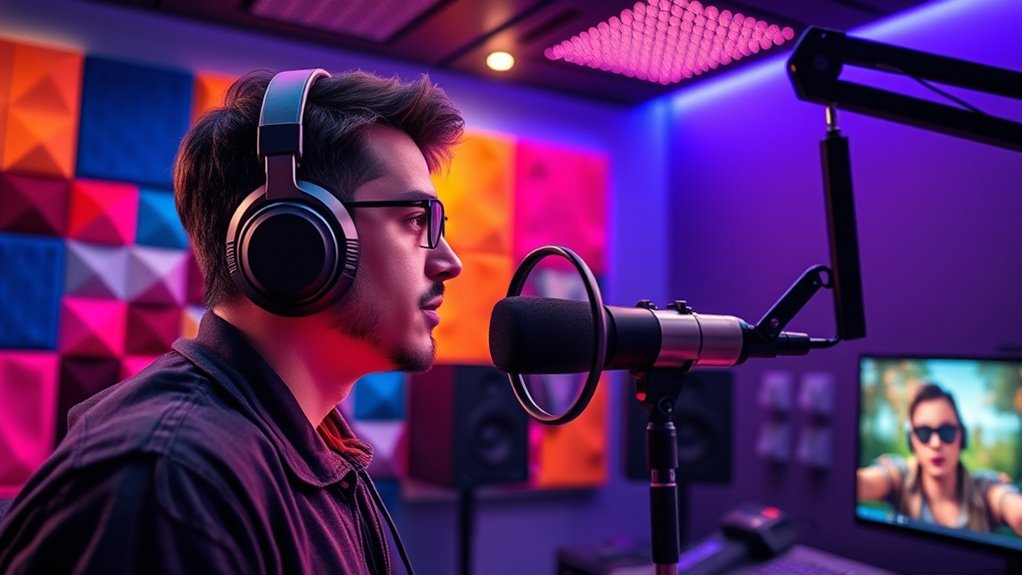
Economic factors such as increasing demand for high-quality gaming experiences and expanding global markets are fueling growth in the voice-over industry. As the gaming market expands, more players are willing to invest in immersive soundscapes, boosting consumer spending. This trend encourages developers to prioritize professional voice-over work, further increasing industry revenue. Additionally, rising consumer spending in emerging markets opens new opportunities for voice actors and studios. The growing popularity of mobile gaming and streaming platforms also contributes to market expansion, making voice-over more essential than ever. High-quality audio technology and equipment are also becoming more accessible, supporting the industry’s growth.
Future Trends Shaping Voice-Over in Gaming
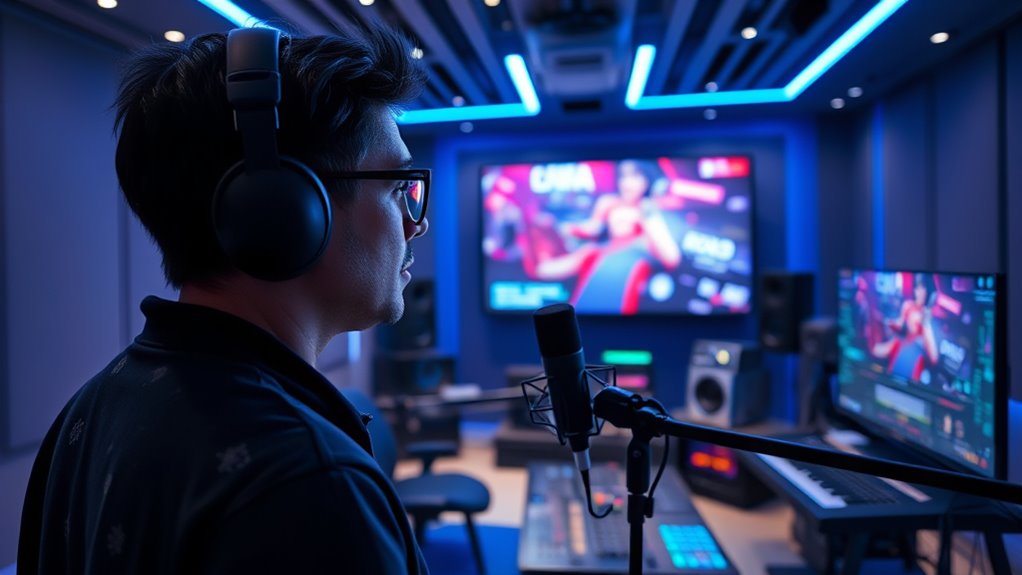
As the voice-over industry in gaming continues to grow alongside economic shifts, emerging technologies and evolving consumer preferences are set to shape its future. Augmented reality (AR) will play a significant role, enabling more immersive experiences where your voice interacts seamlessly with virtual environments. Voice biometrics will also become more prevalent, allowing games to recognize your voice and personalize interactions instantly, enhancing engagement and accessibility. Future trends suggest you’ll see more dynamic, real-time voice adaptation, making characters sound more natural and responsive. These advancements will not only improve storytelling but also create more intuitive interfaces. As a gamer, you’ll benefit from richer, more personalized experiences driven by innovative voice technologies that bring virtual worlds closer to reality. Artificial intelligence is expected to further refine voice synthesis and recognition, leading to even more realistic and adaptive voice interactions in gaming environments.
Frequently Asked Questions
How Do Voice Actors Get Cast for Specific Game Roles?
You get cast for game roles through audition processes, where you showcase your voice and acting skills. Talent agencies often help connect you with casting directors and game developers, increasing your chances. You might record demo reels or attend auditions, either in person or remotely. Your experience, unique voice, and ability to bring characters to life make you stand out, helping you secure the roles you’re passionate about in this growing industry.
What Are the Typical Pay Rates for Game Voice-Over Work?
Imagine earning enough from voice-over work to buy a spaceship—that’s how lucrative it can be! Typically, your pay rate benchmarks depend on the project’s scope, experience, and union status. During voice-over negotiations, you might earn anywhere from $200 to $1,000+ per session, with some top-tier roles paying even more. For longer projects, royalties or residuals could boost your income, making this a rewarding career choice.
How Do Licensing Rights Affect Voice-Over Recordings in Gaming?
Licensing rights directly impact your voice-over recordings in gaming by governing how your performance can be used. You’ll need to comprehend the licensing agreements, which specify whether your voice is exclusive or non-exclusive, and how long your recordings can be used. This relates to intellectual property, as your voice is protected under copyright law. Clear licensing terms ensure you’re fairly compensated and that your rights are protected throughout the game’s development and distribution.
Are There Differences Between Indie and AAA Voice-Over Production Processes?
You’ll notice differences between indie and AAA voice-over production processes. Indie projects often work with lower budgets and tighter schedules, which can impact production quality and lead to simplified recordings. In contrast, AAA productions have bigger budgets, allowing for higher production quality, multiple takes, and professional studios. This means AAA voice-overs typically sound more polished, while indie projects might focus on efficiency and cost-effectiveness to meet their budget constraints.
How Do Voice Actors Maintain Consistent Character Voices Across Multiple Games?
Many believe maintaining voice consistency across games is impossible, but with careful character development, you can accomplish it. You record multiple takes, analyze your character’s traits, and work closely with directors to stay true to the voice. Repeating key phrases and referencing previous performances help reinforce the voice. This dedication ensures your character remains authentic, creating a seamless experience that keeps players connected and immersed in your game’s story.
Conclusion
You now see how the voice-over industry in gaming has exploded into an unstoppable force, shaping worlds and stories with every spoken word. As technology advances and opportunities multiply, you’re part of a revolution that’s bigger than any blockbuster. This billion-dollar industry isn’t just growing; it’s redefining entertainment itself. Get ready to witness and maybe even influence the future of gaming’s most mesmerizing soundscape—because this is just the beginning of an audio universe without limits.









